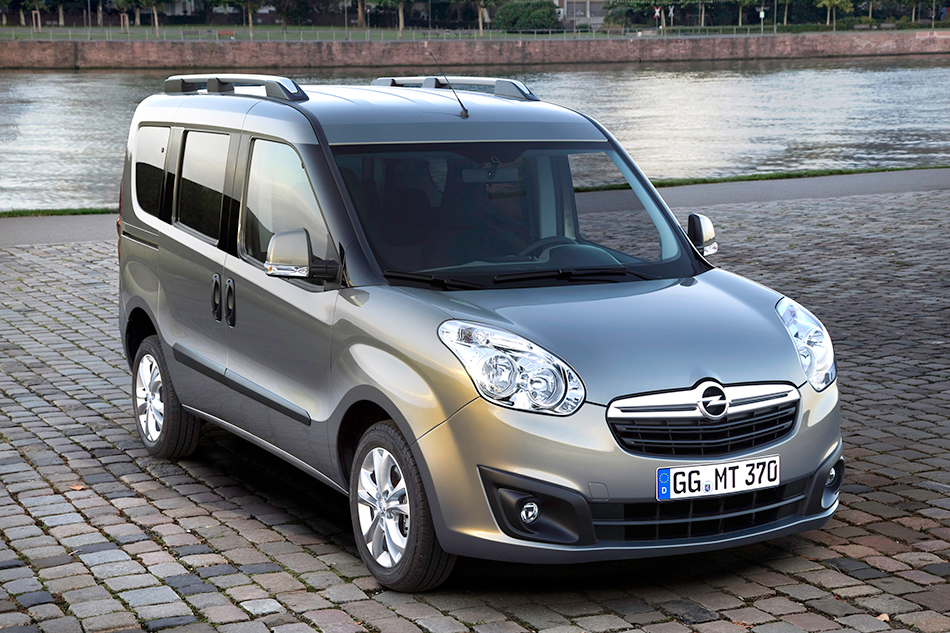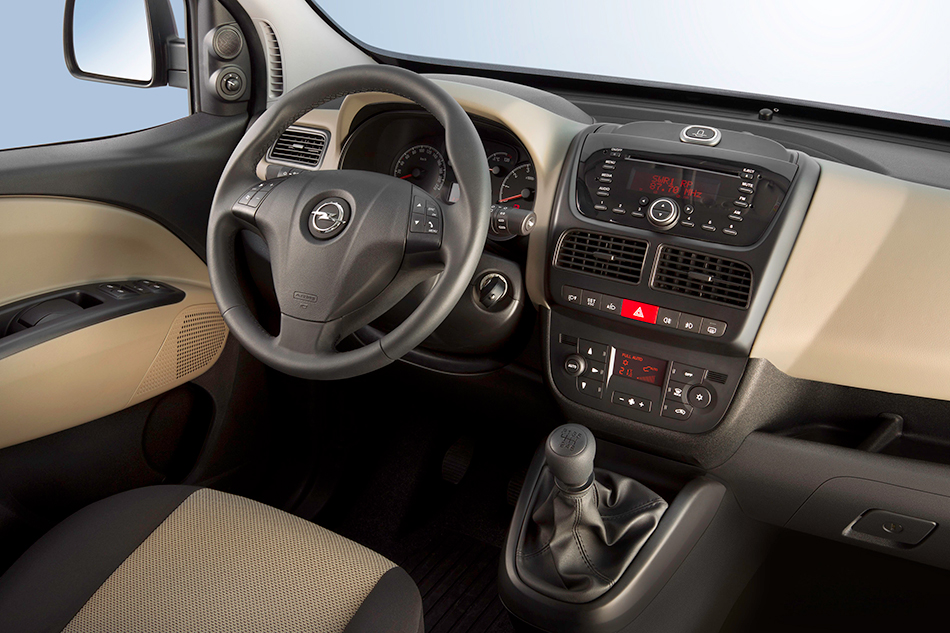Now in its third generation, the new Opel Combo sets new standards in terms of its diversity of models and boasts "Best in Class" results in terms of functionality and utility, positioning it as a leader of the European Van-B segment. With its diversity of talents, the new Combo is the perfect way to round off Opel's product spectrum in the area of light cargo vans as well as leisure and family vehicles.
The all-rounder which is available in different body styles is based on the Fiat Doblo ("International Van of the Year 2011") of Opel's cooperation partner. The aim of this strategic alliance is to drive Opel's growth in the area of commercial vehicles. Alongside its larger stable mates, the Vivaro (D-Segment/up to 2.9 t) and the Movano (E-Segment/up to 4.5 t), the new Combo provides the basis for a highly competitive offering that now consists of three model ranges. This trio will strengthen Opel's commercial vehicle segment and make it one of the central pillars of the brand.
Growth in the European Van-B segment is predicted to be one million units until the year 2015. 62 percent of all Combo sales are predicted to be for the Cargo van variant, 38 percent for the passenger "Tour" variant.
Opel has been selling the Combo since 1985 and the current generation has been around since 2001. The versatile concept of a diverse leisure, family and commercial vehicle has been very popular. Even during the final phase of its lifecycle, the predecessor of the new Combo was still in the top three of its segment in many European markets.

Diverse spectrum of body styles
The new Combo fulfills a broad spectrum of criteria due to its great diversity of models.
The spectrum of models comprises two basic types of bodywork: those with short and long wheel bases (2,755/3,105 mm). Both types are available as a transporter variant (Cargo) as a panel van or glazed and as a five to seven seat versions for carrying passengers (Tour). The variants with short wheelbase can in addition be ordered with standard or high roofs. Therefore the Combo model spectrum provides a flexible basis for the professional use in business or industry and constitutes a versatile multi-purpose family and leisure vehicle.
Best in Class for payload and load capacity
The new Opel Combo in its panel van version leads several segments in terms of capacity and payload. The "Cargo" version boasts an impressive set of segment leading stats, including the longest wheel base in the segment (3,105 mm), the biggest payload in segment of up to 1 ton (including driver), the largest load capacity in segment with up to 4.6m3 in volume and the biggest rear axle load in segment of 1,450 kilograms. The Combo also boasts "Best in Class" status for the longest maximum load length (3,400 mm) and height (1,550 mm) as well as the largest back door opening in the segment (height/width: 1,455/1,231 mm) and finally the lowest loading bay threshold in the segment (545 mm).
For passenger transport, there is the Combo Tour with five-seats and a short or long wheel base, sliding doors as standard, and tailgate or asymmetrical rear doors. The five-seat passenger variant with a short wheel base is also available with a high roof. The passenger car versions offer impressive transport capabilities with a loading capacity of up to 3,200 liters (long wheel base) and payloads of up to 800 kg.
Broad engine spectrum
The new Opel Combo offers a diverse and competitive spectrum of powertrains, including four diesel engines, one gasoline unit and a CNG version (Compressed Natural Gas) which operates as a dual fuel unit with gasoline. All engines are available with the particularly fuel efficient and environmentally sound ecoFLEX technology complete with Start/Stop technology. The basic diesel 1.3 CDTI model as well as the Combo CNG version also carry the ecoFLEX label due to their low emissions.
The diesel engines of the new Opel Combo possess the latest Common-Rail technology, an oxidation catalyst, and a diesel particulate filter. Even the 1.3 CDTI 66kW/90 hp ecoFLEX, is capable of fuel consumption and CO2 emissions of between 4.8 and 4.9 liters per 100 kilometers, or between 126g/km and 129g/km respectively, depending on the body version, trim and roof height. This means the engines are performing at the top end of the Van-B segment within their displacements categories. Only for the high spec Combo "Tour" passenger variant an equally powerful CDTI variant with 1.6 liters is offered. It comes with a manual six speed transmission and is optionally available with the five-speed easytronic transmission. The next level on the performance scale is the 1.6 CDTI with 77kW/105 hp, while the 2.0 CDTI engine with 99kW/135 hp sits at the top of the diesel powertrain spectrum of the Combo. It is equipped with a six gear manual transmission and delivers torque of 320 Nm, making it a superior and powerful unit in its class.
Customers who appreciate the qualities of a smooth gasoline engine will not be disappointed with the 70kW/95 hp 1.4 liter unit. Those who favor alternative propulsion can opt for the 1.4 CNG ecoFLEX engine (88 kW/120 hp). The engine, which is geared towards dual fuel usage of gasoline and natural gas, is particularly suited to the environment and efficiency. In the case of the 1.4 CNG ecoFLEX version, the Opel Combo holds a 22 liter gasoline tank and CNG cylinders with a total volume of 95 liters or 130 liters (only available in long wheelbase). This results in considerable maximum ranges of up to 625 and 750 kilometers respectively.
Long service intervals, low running costs
Long intervals between servicing helps to reduce the running costs: for the gasoline and CNG models a routine service every 30,000 kilometers is recommended. The recommendation for diesel versions is every 35.000 km/1 year. Low fuel consumption, service and maintenance charges give the new Combo a leading position in the European Van-B segment in terms of economy.
A recent report focusing on cost of ownership in Germany shows that after three years and 90,000 kilometers, the Combo Cargo 1.3 CDTI retained 39.3 percent of its list price. The Combo passenger 1.6 CDTI variant even retained 42.9 percent of its original price. Both versions of the Combo are in the top three of their segment for overall running costs, according to the report. This is after tax, insurance, maintenance, spare parts, wear and tear and value retention have been taken into account.
Sophisticated Bi-link rear suspension
In terms of its handling as well as its active and passive safety features, the new Combo also assumes a leadership role in its class. The innovative Bi-link rear wheel suspension significantly helps to improve the handling of the vehicle and ensure a smooth ride.
The compact and kinematic dimensions of the rear axle link enable a full loading width of 1.23 meters between the wheel arches which enables the transportation of Euro pallets.
Additionally the rear axle can take weights of up to 1,450 kilograms, giving the Combo plenty of scope for big payloads.
Cabin packed full with functional and ergonomic kit
The cabin of the new Opel Combo is brimming with practical and user friendly features. Ergonomic and accessible controls create a harmonious feel inside the cabin. The layout of the cabin comes across as well thought-out and practical because of a number of well-placed and functional storage compartments and shelves as well as the availability of up to seven seats (third row seats removable) and not least the 60 – 40 split ratio of the foldable rear bench.
The new Opel Combo is able to satisfy a wide range of diverse customer needs and equipment requirements with its three trim variants "Essentia", "Enjoy" and "Cosmo". Even the entry level trim "Essentia" (always applies to Combo Cargo) comprises an adjustable steering column (longitudinal and tilt), electric front windows, a driver airbag and ABS complete with EBD (electronic brake-force distribution). Standard features in the "Tour" passenger variant are a child seat fixation in line with ISOFIX standards on the fron passenger seat and the outer seats of the second row.

With the trim packages: "Enjoy" and "Cosmo, passenger variants have another two trim levels to choose from. Both offer the customer especially configured interior fabrics and design, comfort and safety features according to individual tastes. Furthermore there is a comprehensive list of optional kit including an anti-slip regulator (ASR) and the ESP complete with brake assistant and Hill Holder system.
Competitive prices
Apart from its attractive features and economy, the new Combo is also highly competitive when it comes to pricing. Prices at entry level start at 13,750 euro (Germany recommended retail price not including VAT) for the panel van "Cargo" version with a 70 kW/95 hp gasoline engine. The motto "lots of car for little money" rings true in this case. The Opel/Vauxhall CEO, Karl-Friedrich Stracke, explains the importance of the new vehicle in the brand's overall product strategy: "By launching the third generation Combo, we have extended our portfolio with another vehicle that can easily compete in the segment of light commercial and multi-purpose vehicles. We are confident that the Combo will quickly make a name for itself in the marketplace because of its versatility and economy. This will help us grow our brand."
Source: Opel






















